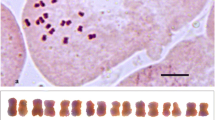Summary
The somatic chromosome numbers have been determined, for the first time for the following species and were found to be as follows:-
-
Bignonia Unguis- cati 2n = 40
-
Heterophragma adenophyllum 2n = 40
-
Markhamia platycalyx 2n = 40
-
Markhamia hildebrandtia 2n = 40
-
Stereospermum xylocarpum 2n = 40
-
Stereospermum suaveolens 2n = 40
-
Tabebuia spectabilis 2n = 40
-
Spathodea nilotica 2n = 26
From the nucleolar behaviour, the number of prochromosomes attached to the nucleolus in some of the species during prophase and from secondary association studies, it is concluded that the 40-chromosomed species are in the nature of allotetraploids with a basic number of 10.
Secondary association was observed inDolichandrone Rheedii and from the maximum association, the number 10 was derived as representing the basic number. The meiotic chromosome counts were made in the following species :
-
Dolichandrone Rheedii n = 20
-
Parmentiera edulis n = 20
-
Tecoma serratifolia n = 19
The tapetum shows a considerable variation in its behaviour in the different members of the family Bignoniaceæ. InStenolobium stans, it disintegrates even before the pollen mother cells enter upon the meiotic divisions. InPhyllarthron comorense also it begins to disappear at an early stage and no trace of it seen after the tetrad stage. In others likeDoli- chandrone Rheedii andParmentiera edulis, the tapetum is of the intrusive type and its cells may protrude inwards to such an extent as to partition the anther loculus. A plasmodial type of tapetum is met with inParmentiera edulis.
Similar content being viewed by others
Literature cited
Clausen, J.Hereditat, 1926,8, 1.
Choudhuri, H. C.Ann. Bot. Lond., 1942,6, 183.
Darlington, C.D.Recent Advances in Cytology, 1937,63.
Heitz, E.Planta, 1931,12, 774.
Mol, CW.deLa Cellule, 1928,38, 1.
Raghavan, T. S., and Venkatasubban, K. R.Jour. Ind. Bot. Soc., 1940,19, 293.
Rendle, A. B.Classifiaction of Flowering Plants, 1930,2, 63.
Roener, W. M. E.Bull. Torr. Bot. Club, 1935,62, 354.
Venkatasubban, K. R.Annamalai University Publi., 1944,1, 2 and3, 1–207.
Wiger, J.Embryological Studies on the Familie. Buxaceæ, Mellaceæ, Simarubaceæ and Burseraceæ. 1935.
Author information
Authors and Affiliations
Additional information
Communicated by Dr. P. Maheshwari,f.a.sc.
Rights and permissions
About this article
Cite this article
Venkatasubban, K.R. Cytological studies in Bignoniaceæ. Proc. Indian Acad. Sci. 21, 77–92 (1945). https://doi.org/10.1007/BF03049809
Received:
Issue Date:
DOI: https://doi.org/10.1007/BF03049809




